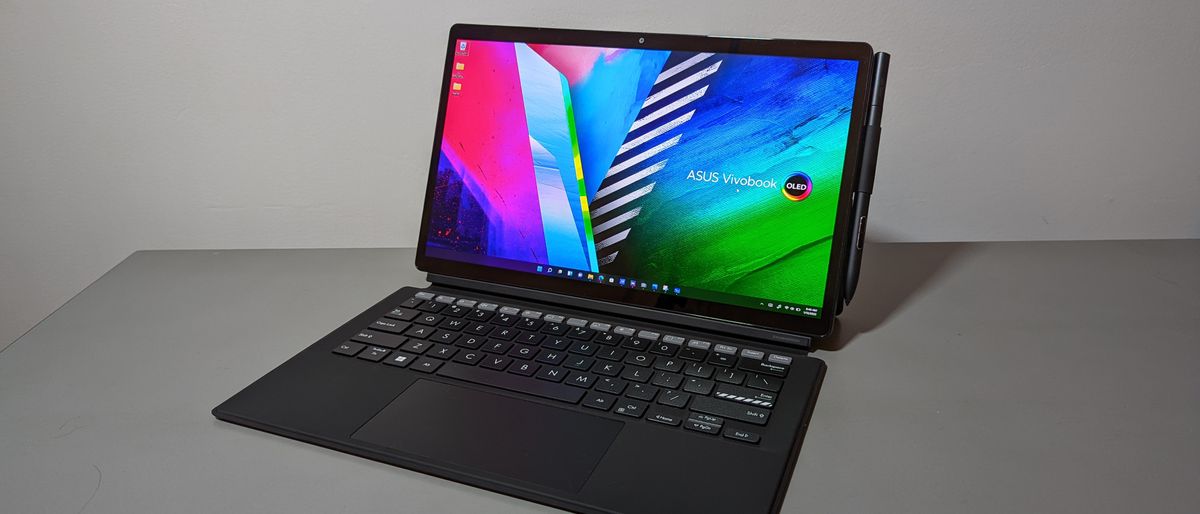Laptop Mag Verdict
The Asus VivoBook 13 Slate OLED disappoints in almost every way that matters, and would be an acceptable device if it didn’t cost as much as better laptops.
Pros
- +
Colorful 13.3-inch, OLED panel
- +
Great cameras
- +
Decent keyboard
Cons
- -
Chunky and heavy when all parts attached
- -
Crappy CPU for the price
- -
Below average battery life
- -
Dimmer than average display
- -
Flimsy kickstand
Why you can trust Laptop Mag
The Asus VivoBook 13 Slate OLED is the flashy new detachable on the block that thinks it can get away with its gorgeous looks alone, but no, girl, you need substance to survive in this world. It’s not all bad though. You get a colorful, 13.3-inch, OLED screen, a competent pair of cameras, and a decent keyboard. But its $600 price point also sticks you with a crappy Intel Pentium processor, below average battery life and a dim display packed into a clunky design with a flimsy kickstand. This doesn’t come close to one of the best cheap laptops no matter how pretty its display is. The VivoBook 13 Slate will slow to a crawl before the year ends and you’ll wonder why you didn’t pick up a more reliable machine.
Asus VivoBook 13 Slate OLED price and configurations
Price: $600
CPU: Intel Pentium Silver N6000
GPU: Intel UHD Graphics
RAM: 8GB
Storage: 256GB SSD
Display: 13.3-inch, 1080p OLED
Battery: 9:27
Size: 12.2 x 7.5 x 0.3 inches
Weight: 3 pounds and 12.2 x 7.5 x 0.3 inches
Ugh. The Asus VivoBook 13 Slate OLED costs a whopping $600 and all it has to show for it is its 13.3-inch, 1080p OLED display. Meanwhile, Asus sticks you with an Intel Pentium Silver N6000 CPU, 8GB of RAM and a measly 256GB SSD. That’s the one and only configuration of the VivoBook 13 Slate OLED.
If you’re looking for some more oomph for an even cheaper price, check out our best laptops under $500 page.
Asus VivoBook 13 Slate OLED design
There are three flimsy pieces that make up the Asus VivoBook 13 Slate OLED. Firstly, there’s the slate itself, which weighs 1.7 pounds. The face features the display surrounded by some chunky bezels and an integrated webcam, while the sides hold room for the ports as well as vents for the speakers. A light black color splashes the back but avoids the glossy VivoBook logo and the webcam, which is surrounded by a gray rectangular piece with weird text: “Wow the world [...] Slate PC [...] cultural originator.”
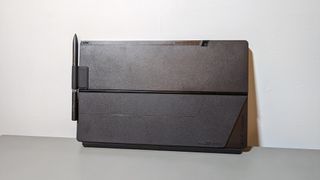
Next is the keyboard (0.7 pounds); apart from its rubbery black texture it looks normal: Touchpad on the bottom, black keyboard above and a neat gray accent lining up the function row. Then there’s the part-kickstand-part-back-cover (0.6 pounds) that keeps falling off of the VivoBook 13 Slate. It’s a hard plastic piece with some subtle glossy lines carved around it to give it a consistent aesthetic with the rest of the chassis. There’s also a set of green slashes, which is where the pen holder is placed thanks to magnets. Unfortunately, the magnetics aren’t very strong on most of the attachable pieces, and the kickstand is the worst of them.
At 3 pounds and 12.2 x 7.5 x 0.3 inches (tablet only), the Asus VivoBook 13 Slate OLED is on the heavier side next to its competitors. The HP Pavilion Aero 13 (2.2 pounds, 11.7 x 8.23 x 0.67 inches) and Lenovo ThinkBook 13s (Gen 2) (2.8 pounds, 11.8 x 8.2 x 0.6 inches) were lighter, while the Acer Chromebook Spin 514 (3.6 pounds, 12.7 x 8.9 x 0.68 inches) was the heaviest thanks to its 14-inch chassis.
Asus VivoBook 13 Slate OLED ports
There aren’t many ports on the Slate OLED, but the ones that it does have are frustratingly placed.
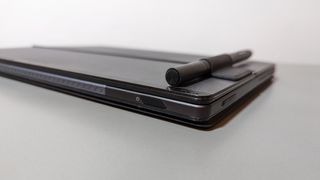
On the left, there’s two USB Type-C ports, a headphone jack, and a MicroSD card slot. There should’ve been one USB Type-C port on the right side so you can choose where the charging wire gets placed. Additionally, the wire included to charge the Asus Pen 2.0 is a USB Type-A to USB Type-C cable. You can’t even charge the pen with the machine you bought. It’s an incredibly frustrating design.
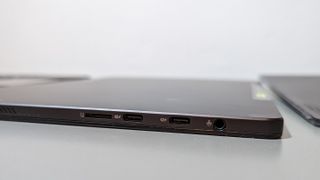
If you buy this device, you’ll need more ports. Take a look at our best USB Type-C hubs and best laptop docking stations pages.
Asus VivoBook 13 Slate OLED display
For all the trouble to get a 13.3-inch, 1080p, OLED display into the Asus VivoBook 13 Slate, it barely surpasses its competitors with color, but it still falls short on brightness.
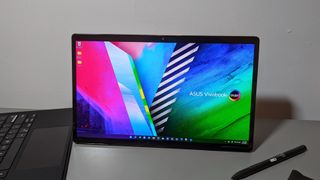
I watched the trailer for Jackass Forever, and Johnny Knoxville’s red scarf popped against his fake green military uniform. In a darker trailer, like Blacklight, I could barely see Liam Neeson’s jacket when he opened his weapons locker due to the dimmer nature of the display. However, each strand of Neeson’s hair was sharp on screen.
On our tests, the VivoBook 13 Slate covered 88% of the DCI-P3 color gamut, which is slightly above the 76.8% mainstream laptop average. However, it’s not easily impressive when compared with the Pavilion Aero 13 (84.7%) and ThinkBook 13s (86%) which were hot on its heels. Meanwhile, the Spin 514 just fell in the dirt with 42.8%.
At 295 nits, we found that the VivoBook 13 Slate is dimmer than the average mainstream laptop (319 nits). It was brighter than the ThinkBook 13s (267 nits) and Spin 514 (209 nits), but the Aero 13 (451 nits) crushed everything.
Asus VivoBook 13 Slate OLED keyboard, touchpad and stylus
For a detachable, the Asus VivoBook 13 Slate OLED has a punchy keyboard, but it does feel pretty flimsy.
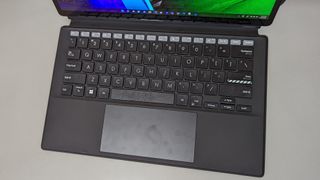
I hit 77 words per minute on the 10fastfingers.com typing test, which is close to my 78-wpm average. Overall, the keys are quite good, but the deck falls short by pure circumstance thanks to its detachable form.
The Asus Pen 2.0 was smooth to use as I attempted to draw a ship (it looked like a creepy face instead). It was pretty frustrating to use with the kickstand because it blows over with the smallest amount of pressure — it really shouldn’t be called a stand at all. The Pen itself features 4,096 levels of pressure sensitivity, two side buttons (one for mouse clicks, one for erase function) and a configurable top button. It also comes with three different tips (H, B, and HB). To charge it, you have to pull out the eraser end to reveal the USB Type-C port. According to Asus, it can last for one year on a charge based on average daily use of two hours, which is marketing speech for it can last 730 hours (~30 days).
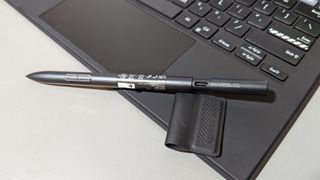
The 5.1 x 2.6-inch touchpad offers a decent amount of space and a satisfying pair of clickers, but in the wrong position, the bottom of the deck can flex and depress on the touchpad. It’s not really an issue unless you attempt to use this device in your lap, which it’s not really designed for.
Asus VivoBook 13 Slate OLED audio
The side-firing speakers on the Asus VivoBook 13 Slate OLED don’t impress, but they’re OK.
I listened to Jessica Darrow’s “Surface Pressure” from Encanto (great movie), and the opening vocals sounded a bit flat, and when the percussion kicked in, there wasn’t enough bass to highlight them. Later in the song, when the piano takes the center stage, I could barely hear it as it was muddled underneath the vocals.
The VivoBook 13 does come with Dolby Atmos, and while that can drastically change the sound with its Music, Movie, Game, and Dynamic settings, it couldn’t make the audio sound good.
Asus VivoBook 13 Slate OLED performance
With just an Intel Pentium Silver N6000 and 8GB of RAM, the Asus VivoBook 13 Slate OLED showed some serious slow down after I opened 10 Microsoft Edge tabs. This thing is not meant for any reasonable workload.
On the Geekbench 5.4 overall performance test, it scored a pathetic 1,897, over half of the mainstream laptop average (4,156). The Aero 13’s AMD Ryzen 7 5800U (5,876), the ThinkBook 13s’ Core i5-1135G7 (5,363), and the Spin 514’s AMD Ryzen 5 3500C (2,792) dominated the Asus.
The VivoBook 13 Slate OLED took a whopping 32 minutes and 16 seconds to transcode a 4K video to 1080p on our HandBrake test, which is double the time it takes the average mainstream laptop (16:34). The Aero 13 (9:05) and ThinkBook 13s (12:21) completed it in a respectable time.
Asus’ 256GB SSD has the pitiful transfer rate of 197MBps, falling short of the category average (643 MBps), the Aero 13 (503 MBps), and the ThinkBook 13s (244 MBps).
Asus VivoBook 13 Slate OLED graphics
The Asus VivoBook 13 Slate OLED’s Intel UHD Graphics chip doesn’t do it any favors, either. On the Sid Meier’s Civilization VI: Gathering Storm benchmark (Medium, 1080p), the VivoBook 13 averaged a measly 6 frames per second, far below the 30-fps mark for playability. The Aero 13 hit 26 fps (AMD Radeon GPU), while the ThinkBook 13s clocked it at 32 fps (Intel Iris Xe GPU).
On the 3DMark FireStrike synthetic graphics test, the Slate scored 1,235, falling short of the 3,774 average as well as the performance from the Aero 13 (3,182) and ThinkBook 13s (4,172).
Asus VivoBook 13 Slate OLED battery life
The battery life is one of the few things that the Asus VivoBook 13 Slate OLED has going for it, but even that isn’t as impressive as it should be compared with other machines in its category. On the Laptop Mag battery test, the VivoBook 13 Slate lasted 9 hours and 27 minutes, dropping behind the 10:21 category average. It did slide past the ThinkBook 13s (9:13) and Spin 514 (7:38), but the Aero 13 persevered with 10:27.
Asus VivoBook 13 Slate OLED cameras
The cameras on the VivoBook 13 Slate OLED are actually impressive. On the front, there’s a 5.0-megapixel camera and on the back there’s a 13.0MP camera.
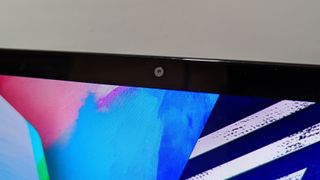
The 5.0MP accurately captured the blue palm trees on my white shirt, and highlighted the sharp ridges on my glasses as well as the strands of hair on my head. It balanced the contrast decently well, too, as the sunlight on my face didn’t create white spots.
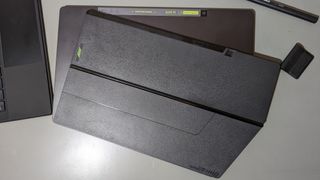
Meanwhile, the 13.0MP did more of the same, except the background wasn’t as noisy, and I could even see some of the pores on my face. I would totally use these cameras to play D&D Online.
Asus VivoBook 13 Slate OLED software and warranty
The only app that Asus put in this thing is the MyAsus app, which is very useful. It lays out your warranty, updates, promotions, battery health settings, display settings, system info, and more.
Surprisingly, I didn’t see any Windows 10 bloatware onboard.
The VivoBook 13 Slate comes with a one-year limited warranty. See how Asus performed on our Tech Support Showdown and Best and Worst Brands ranking.
Bottom line
I wanted to love the Asus VivoBook 13 Slate OLED for its gorgeous display alone, but once I tallied up its cons, from its crappy processor to its flimsy design, I had some serious doubts. Then I found out that the display isn’t really all that to begin with — so what was the point?
Save yourself some struggle and stress, and go with the Aero 13. It’s way more portable thanks to its super light 2.2-pound design, it features a brighter display, and it’s only $200 more to get a CPU, RAM, and SSD that crushes the VivoBook 13 Slate.
I wouldn’t recommend the Asus VivoBook 13 Slate OLED. Just buy something else.

Rami Tabari is an Editor for Laptop Mag. He reviews every shape and form of a laptop as well as all sorts of cool tech. You can find him sitting at his desk surrounded by a hoarder's dream of laptops, and when he navigates his way out to civilization, you can catch him watching really bad anime or playing some kind of painfully difficult game. He’s the best at every game and he just doesn’t lose. That’s why you’ll occasionally catch his byline attached to the latest Souls-like challenge.
